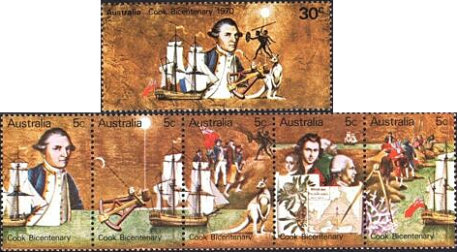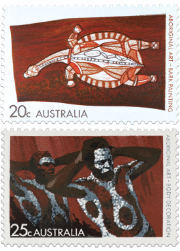History
Timeline results for 1970 to 1999
Found 232 results for your search. Showing page 1 of 12.
Year from 1970, year to 1999
1970
-
Some people from Maningrida in the Northern Territory returned to a preferred traditional way of life on their home estates. These estates were called ‘outstations’ and later ‘homeland centres’. By 1972 many people had moved back to their traditional homelands.
-
Aboriginal Medical Service formed in Redfern, Sydney.
-
Limited land lease rights are given to Aboriginal people on Northern Territory reserves.
-
In the 1970s, the Moree Boomerangs re-emerge after 30 years of abstinence from the rugby league. They can trace their playing days back to the 1940s. The team has included the likes of Phil Duke, Paul Roberts, Ewan McGrady, Dennis Kinchela and Mark Wright.
-
A stamp issue for Australia's 200th anniversary of "first European contact" at the east coast centres around Captain Cook. A mini sheet issued by Australia Post annotates the third stamp of the series (which shows Aboriginal people in the top right corner) with "where he finds new people and strange animals", conveniently omitting conflict.

The Bicentenary issue put Aboriginal people into the far background. Can you spot them?
1971
-
Aboriginal workers walk off the Noonkanbah cattle and sheep station in Western Australia to stop oil drilling on a sacred site.
-
Gumatj Elders Millrrpum and others take on Nabalco Pty Ltd and the federal government in the Gove land rights case following on from the Bark Petition. The Northern Territory Supreme Court ruled that Aboriginal people did not, under Australian law own the Arnhem Land reserve. This meant Nabalco could mine bauxite from the land.
-
Jack Charles and Bob Maza found the first Aboriginal theatre company Nindethana.
-
Larrakia people ‘sit-in’ at Bagot Road, Darwin as a protest against theft of their land.
-
NSW Aboriginal Legal Service is formed, followed by Aboriginal pre-school, Black Theatre and the Aboriginal Housing Company.
-
Aboriginal player Evonne Goolagong wins Wimbledon Women’s Singles title.
-
Aboriginal people are counted in the national census for the first time.
-
Principals of schools in New South Wales are no longer able to exclude Aboriginal children because of home conditions or community opposition.
-
The Second NSW Teachers Federation Survey finds that 27% of Aboriginal students now reach Year 10 and classifies 38% as ‘Slow learners’.
-
Queensland Aborigines Act is passed, maintaining some legal restrictions for Aboriginal people living on reserves. Aboriginal cultural customs are banned and reading matter, mail, recreation, and marital and sexual relationships are censored. Their work and wage worth can be decreased and their movements recorded.
-
Dennis Walker and Sam Watson open the first and only ever Australian chapter of the Black Panther Party (an anti-racism left wing US organisation) in Brisbane. They monitor police activity and the amount of young black men vs. young white men taken into the prison system for the same crime. The party ceased in 1973. [1]
We followed Aboriginal defendants through – recording and comparing the sentencing trends so we could show that Aboriginal people were the most overarrested and overincarcerated people in the entire Australian community.
— Sam Watson, Aboriginal activist [1] -
Aboriginal flag is designed by Luritja artist Harold Thomas and flown for the first time in Adelaide.
-
Evonne Cawley, an Aboriginal tennis player, receives the Australian of the Year award. ⇒ Famous Aboriginal people
-
Neville Bonner becomes the first Aboriginal Member of Parliament, filling a casual Senate vacancy. In 1972 he is elected on the Liberal Party ticket in Queensland. Senator Bonner continues to represent Queensland as a Liberal Senator until 1983.
-

The first issue showing Aboriginal art did not mention the artist but avoided culturally sensitive material. Australia Post releases the first stamp issue to focus on traditional, authentic Aboriginal art forms, titled "Aboriginal Art". While focusing on traditional arts forms, the stamps does not yet name the artist (which started with the 1988 issue).
The 20c design is based on a bark painting of a long necked tortoise from Western Arnhem Land; the 25c, was based on a photograph by Australian anthropologist, Sir Baldwin Spencer (see below); the 30c shows rock paintings of a cave in the Oenpelli area of Western Arnhem Land; the 35c depicts grave posts used in mourning ceremonies on Bathurst & Melville Islands.
The 25 cent stamp shows body decoration used in the final mourning ceremony by the Warramunga people, from the Tennant Creek area in the Northern Territory. The image shows two men in the act of painting each other, which the Warramunga people considered a sacred ceremony to be only witnessed by men. The artist changed the final design so women can also view it. [2]

